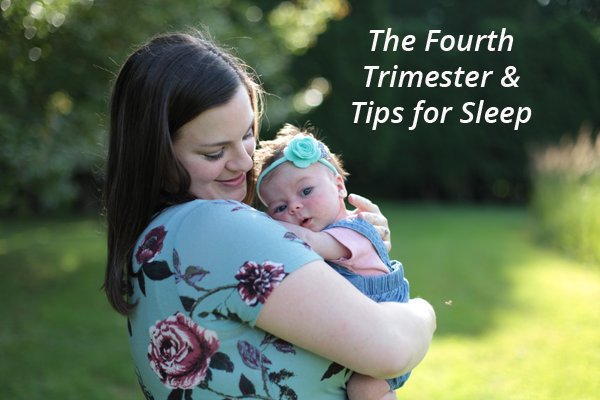
The Fourth Trimester and Sleep
The fourth trimester and sleep: there’s no doubt that you’ve heard about the three trimesters of pregnancy, yet a relatively new concept, called the fourth trimester, is becoming quite popular. Dr. Harvey Karp was the first to introduce this idea of the fourth trimester in his 2015 book, The Happiest Baby on the Block.
What is the Fourth Trimester?
Karp’s theory is that human babies were meant to remain in the womb much longer than 40 weeks. However, if they stayed in the womb any longer, their heads would not fit through the birth canal. Therefore, they need to come into this world before they are actually ready for it. Many other mammal babies are born with the abilities to walk and find their own food, among others. They come out with basic skills to live in their new world. Human babies do not.
Newborn babies rely on their parents for literally everything they need. The new world outside of the womb is vastly different from the home they have lived in for the past nine months, and they don’t know how to handle it. Transition is the theme of the fourth trimester. Both mom and baby need time to shift into this new life together. Similar to a trimester of pregnancy, the 4th trimester lasts about three months, beginning at birth.
The Fourth Trimester and Sleep Issues
New parents likely know to expect little sleep during this 4th trimester. First of all, brand-new babies have very small stomachs. Therefore, they need to eat every few hours, even through the night. However, once your pediatrician has seen an established growth pattern, and there are no other health concerns, you may get the go-ahead to let baby sleep as long as possible at night. When this happens, it may start with a 5-hour stretch, then a 6-hour stretch, and then more! Some babies are able to “sleep through the night” (8-12 hours) by the end of the newborn stage. Beyond needing to eat through the night, there are some other common sleep issues that parents experience during the 4th trimester.

Day and Night Confusion
During pregnancy, you may notice that baby is more active at night, when you are still. The baby is then lulled to sleep by your movements during the day. For this reason, many babies come out with their days and nights reversed. They love to sleep all day and are then up all night. It’s not fun for a new parent who misses sleeping at night!
The best way to reverse your baby’s nocturnal tendencies is to treat day like day and night like night. This means during the day, keep light and sound at a normal volume, even when the baby is sleeping. We have a tendency to tip-toe around a sleeping baby. However, you want him to learn that there is a difference between sleeping during the day and sleeping at night.
Then at night, keep the lights dim and sounds low, even when the baby is awake. Many new parents make the mistake of treating night-time wake-ups as if it was daytime. They figure if they’re up, they may as well turn on the lights, grab a snack, and catch up on a TV show while feeding the baby. This confuses the baby into thinking it’s time to be awake, which will only encourage the problem. Make night-time feedings and wake-ups as quick and quiet as possible. If you do this consistently, your baby will realize that there is a difference between day and night pretty quickly. He will then start taking his longest stretches of sleep at night instead of during the day.
Also, don’t underestimate the power of the sun. A little bit of sunshine each day will help reset your baby’s internal body clock. I’m certainly not suggesting lying your baby out to sun-bathe. A short walk or a tour around the backyard will go a long way. If it’s cold outside, you can still get a little sunlight through the window.
Fussiness / Fighting Sleep
Think about how I explained the 4th trimester above. Your baby is all-of-a-sudden in a new world with no skills to navigate it. When you think of it that way, it’s easier to understand why babies may be so clingy and fussy at times. They are just trying to figure out this big, new world. With you is where he is most comfortable doing so.
The witching hour is a time of day when many babies experience fussiness for no apparent reason. They’re fed, dry, warm, and yet they just won’t calm down. They often fight sleep during this time too. This usually happens in the evening hours. Even though the term witching hour suggests one hour, it can last most of the evening for some babies.

The 5 S’s
In Karp’s book, he talks about the 5 S’s. I have had great success with this in my own experience as a parent and sleep consultant. Babies are used to a lot of noise and movement in the womb. It’s also very close quarters in there, especially towards the end. The 5 S’s are meant to mimic what life was like in the womb. These things will help your baby transition during the 4th trimester. If you have a particularly fussy baby, one or more of these things might do the trick.
Swinging: There is a lot of movement in the womb. Babies are constantly rocked by your movements, so rocking and swinging are very soothing. Just remember, baby gear, like a swing, is not meant for unsupervised sleep. It may work wonders for calming a fussy baby, though.
Side/Stomach: Babies are in all types of crazy positions in the womb, however, lying flat is not one of them. Fussy babies may be calmed by holding them on their side or stomach. It is not recommended to put your baby on his stomach to sleep; however, you can certainly do this to calm him.
Shhh-ing: It’s also very loud in the womb. Your baby hears the constant whooshing of blood pulsing through your veins. A loud shhing sound can really help. If you can barely hear the sound of your shhing over the crying…get louder!
Sucking: Sucking is an innate motion for babies, meaning you don’t have to teach it. They come out of the womb knowing how to suck. Some babies have even been seen sucking their thumbs in the womb! Letting baby suck on a pacifier, clean finger, breast, or bottle is a great way to offer comfort!
Swaddle: As I mentioned above, it’s tight in the womb. They don’t have room to stretch out, and this gives them a feeling of security and warmth. A swaddle helps to mimic the tightness of the womb. There are so many different types of swaddles. In my experience, modern swaddles that zip or Velcro shut are better than a simple swaddle blanket. No matter how tight you wrap a blanket, most babies will find their way out of it. Just a note: If your baby cries while you’re swaddling him, don’t assume he doesn’t like it. Some babies don’t like the action of being swaddled, but are still soothed by it once they are in it.
These 5 S techniques can help calm babies and get them to sleep! Try one or all of them. The 4th trimester is about finding what works for baby and using it to transition them into this world.
Needing to be Held to Sleep
Many babies do not come out loving to sleep on their own, flat on their back. Some do, and if you have one of those, consider yourself very lucky! For the rest of us, taking shifts of sitting up and holding the baby all night long may be a harsher reality. Babies love to be held. It makes them feel warm, safe, and secure. This is why some parents start co-sleeping. With the majority of co-sleeping families I have worked with, that sleeping arrangement was never their intention. It happened because they didn’t know how else to get any sleep early on.
All I can say for this is: practice. Practice putting your baby down to sleep, even if it’s just for a short nap once a day. Once baby comfortable with that, try putting your child down for another nap. Practice putting baby down while awake too. The more you practice, the more comfortable baby will get with it. If he cries, pick him up, offer comfort, and try again another time.
Enjoy the Transition!
Remember, the 4th trimester is all about transition. You have to help baby move from the comforts of the womb into this great, big world. Go slow and be patient. It won’t last forever. Those full nights of restful sleep will come again, and you will soon miss these days of holding a sleeping newborn on your chest!

Article by Ashley Bell, Pediatric Sleep Consultant, Little Bell Sleep Solutions. Photograph by Kate Stutz.
